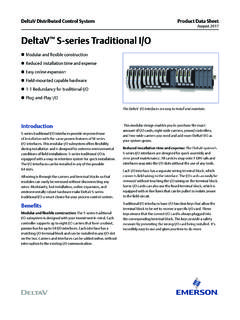Transcription of IP Multimedia Subsystem : Principles and Architecture
1 IP Multimedia Subsystem : Principles and Architecture Simon ZNATY and Jean-Louis DAUPHIN. EFORT. 1 Introduction Many successful services are available today on the Internet, including e-mail, web browsing, chat, and audio and video downloading/streaming. Internet telephony and Multimedia Communications Services, some of the latest to be launched, are already being proposed by Microsoft MSN, AOL and Skype. As telephony is simply another Internet application, any company, even if it is not an access provider, can provide a telephony service.
2 The above actors are already active in this market, but are all proposing proprietary Internet telephony solutions. In this context, the operators which telephony service was their core business, are facing the following alternatives : 1. Reposition their business towards value-added IP services including telephony, becoming global service providers. In this case, they will have to rapidly push IMS before proprietary solutions become largely adopted. IMS is the only standardized solution in the telecommunications world.
3 2. Abandon the market of value added services including telephony and reduce their business to that of a commodity access provider or IP packet transporter. The difficulties will be to maintain revenues in a context where the access and transport will become a commodity business under strong price pressure and of little interest to users. IMS I P Mul t i medi a Subsy stem st andardized byt he t elecommuni cat ionswor l di sanew Architecture based on new concepts, new technologies, new partners and ecosystem. IMS.
4 Provides real-time Multimedia sessions (voice session, video session , conference session, etc) and non real-time Multimedia sessions (Push to talk, Presence, instant messaging) over an all-IP network. IMS targets convergence of services supplied indifferently by different types of networks : fixed, mobile, Internet. IMS is also called Multimedia NGN (Next Generation Network). IMS deployment is a strategic decision, not a network technology decision. It can be taken either by a traditional service provider in the context of repositioning its business on IP.
5 Services or by any entity that would decide to start an activity in IP services even without owning an access or transport network. Acquisition of the basics of IMS Architecture and standards, in particular specification of specific protocols and interfaces such as SIP, Diameter, COPS, and the knowledge of the vendor ssol uti onsal r eadyav ail ablear eessent i alforanyst akeholder net wor kors ervice provider, telecommunications vendor, or customer that wants to be an actor in the emerging business of value added IP services.
6 This white paper presents the IMS Network and Service Architectures with the underlying concepts, involved entities and their functionalities. Copyright EFORT 1. 2 IMS Architecture The IMS (IP Multimedia Subsystem ) vision is to integrate mobile/fixed voice communications and Internet technologies, bringing the power and wealth of internet services to mobile and fixed users. It allows the creation and deployment of IP-based Multimedia services in the 3G. networks. IMS can enable IP interoperability for real-time services between fixed and mobile networks and so holds the promise of seamless converged voice/data services.
7 Services transparency and integration are key features for accelerating end-user adoption. Two aspects of IMS are of fundamental importance to deliver these features : IP-based transport for both real-time and non-real-time services Introduction of a Multimedia call model based on SIP (Session initiation Protocol). The IMS will provide: A multi-service multi-protocol, multi-access, IP based network - secure, reliable and trusted Multi-services: Any type of service may be delivered by a common QoS enabled core network, Multi-access: diverse access networks (WiFi, WiMAX, UMTS, CDMA2000, xDSL, Cable, etc.)
8 Can interface with IMS. IMS is Not one network, but different networks that interoperate seamlessly thanks to roaming agreements between any type of IMS service provider. IMS is An enabler for Service Providers to offer : Real-time and non real-time, communication services between peers, or in a client-server configuration. Mobility of services and mobility of users (Nomadicity). Multiple sessions and services simultaneously over the same connection. One can get his communications services anywhere, on any terminal.
9 Layers of the IMS Architecture The IMS Architecture as defined by the 3 GPP standards is an all-packet core network that creates an access-agnostic environment to deliver a wide range of Multimedia services that a user can access using any device or network connection. Leveraging the SIP protocol, IMS. supports IP-to-IP sessions over any wireline connection ( , DSL, cable) or wireless network protocol ( , Wi-Fi, GSM or CDMA). The IMS infrastructure allows a carrier to interwork between the TDM and IP networks to provide a seamless service experience.
10 Access layer : IMS is access independent. In case of mobile, it can be GPRS, EDGE (also called enhanced GPRS), UMTS or Wireless LAN. 3 GPP UMTS R5 focuses on EDGE and UMTS accesses. 3 GPP UMTS R6 adds WLAN. 3 GPP2 assumes cdma2000 accesses. Fixed service providers will apply IMS to ADSL and cable network accesses. Transport layer : It is an all-IP network that consists of IP routers (edge and core IP routers). Connectivity layer = Access Layer and Transport Layer Session Control layer : Comprises network control servers for managing calls or establishing sessions and modifications.






